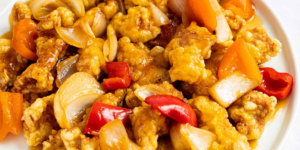INTRODUCTION
Tangsuyuk, which might also be referred to as Korean sweet and sour pork, is a meal that is exceedingly well-liked by the Korean people. This dish is what people in Korea typically refer to when they talk about it. The pork is given a crispy texture by being double-fried, and the sauce is utterly delicious due to the fact that it strikes the ideal balance between sweet and sour flavors. The overall appeal of the meal is enhanced by the presence of both of these components. I really hope that you don’t have any negative experiences with it!
In addition to being known as 탕수육, tangsuyuk is a sort of pork (or beef) that has been marinated and then deep-fried. It is then served in a sauce that is a pleasant combination of sweet and acidic flavors. This dish, which is more commonly associated with Chinese cuisine and consists of sweet and sour pork (or beef), has been modified to accommodate the preferences of Korean diners. Tangsuyuk, which can also be spelled tangsooyuk, is a dish that is considered to be a popular form of Korean cuisine. It is a combined dish of Korean and Chinese cuisine. Not only does it fall under the category of lunches consisting of noodles, but it is also in the same category as jajangmyeon and jjamppong.
When we go out to eat at a Korean-Chinese restaurant, my family always orders a large platter of tangsuyuk to share as an appetizer. This is something that we do on a regular basis. Being able to accomplish this together is something that we enjoy doing. In terms of the frequency with which we participate in this activity, it is extraordinarily high. This is a recipe that I typically make at home for large gatherings or parties, particularly when my extended family gets together, just like my mother used to do on those occasions. I try to make it as similar as possible to what she used to make. This is something that I do because I want to take part in the same experience that my mother did. Every single person is completely awestruck by it!
The method of making tangsuyuk is not only simple, but it also requires a very small amount of time when taken into consideration as a whole. As a result, prior to beginning the cooking process, you want to make certain that all of the items and apparatus that you will require in the kitchen are assembled. In September of 2011, not long after it was initially published, this recipe for tangsuyuk was initially uploaded on the internet for the first time. This article has been updated with new photographs, additional information, and a rewritten recipe; all of them may be found on this page. Other updates include additional information.
WHAT IS TANGSUYUK ?
Tangsuyuk, which is also referred to as Tang soo yook or Tang su yuk (also spelled as 탕수육), is a well-known Korean cuisine dish that is served with pork strips that have been deep-fried and a sweet and sour sauce. Most of the time, it is enjoyed in a communal environment, and it is often served as a main meal with Jajangmyeon, which are noodles made with black bean, and Jjamppong, which are noodles made with spicy seafood. Both of these dishes are considered to be popular dishes in South Korea.

For this particular dinner, you have the option of using either pig, beef, or chicken as the meat product. Following the application of seasoning, battering, and deep-frying, the meat of choice is prepared in this manner.
The sauce that is used in the creation of tangsuyuk is made by combining pineapple juice, soy sauce, vinegar, water, and sugar. This mixture is then utilized to form the sauce. For the purpose of imparting a crunchier texture, the dish incorporates a variety of vegetables, such as carrots, cucumbers, and bell peppers, among others.
In general, tangsuyuk is a dish that is crisp and has a wonderful sauce that is a combination of sweet and sour flavors. Tangsuyuk is a food that is enjoyed by many.
MY TOP ADVICE ON MAKING THE IDEAL TANGSUYUK AT HOME
1. Batter
Soaking the starch in water is going to be a vital step in the process of making the batter that will be utilized for frying. All the way through the process of preparation, this will be carried out. On the other hand, if you wish to submerge the starch in water, you should not mix or whisk it with the water; rather, you should gradually flatten it with a spatula. You will be able to dissolve the starch in the water if you do this instead. You do not need to dedicate a significant amount of time to this activity; all that is required of you is to sit on the kitchen bench for ten to twenty minutes. This is the only thing that is asked of you. Because of this, the water and starch will be able to separate, which will contribute to the formation of a tangsuyuk coat that is crisp. This will be a consequence of this. It is required to deep-fry the meat twice in order to achieve an additional level of crispiness in the flesh. This is a really important stage.
2. A sauce that is both sweet and sour
In order to create a tangsuyuk sauce that is of high quality, it is essential to achieve the perfect equilibrium between the sweet and sour flavors. In spite of the fact that my recipe produces a flavor that is well-balanced, you are free to alter the components in any way that you see fit in order to accommodate your preferences.
The utilization of vibrant and fresh vegetables is an additional part of this sauce that is crucial to its composition. Not only can they provide a range of sensations, such as crunch or bite, but they also add a cheery and bright touch to a presentation that is guaranteed to attract people’s attention. I made use of a variety of veggies, including pineapple, carrots, onions, cucumbers, and bell peppers of varied hues. I also used bell peppers. You can combine extra fruits or vegetables, such as apples, kiwi pieces, or wood ear mushrooms, in order to produce a flavor profile that is one of a kind. This can be accomplished by including these ingredients.
3. Instructions on How to Serve
There are two various tasting sensations that can be had with the meat and the sauce when it comes to the manner in which tangsuyuk is presented in a restaurant. These experiences can be distinguished from one another. In the first method, which is known as “Jjikmeok (찍娹),” individuals have a preference for having the sauce on the side and then dipping the meat into it while they are eating. The most recommended approach is this one. At your discretion, you have the choice to pour the sauce over the meat, which is commonly referred to as “Bumeok (宀稹).” In contrast to the conventional approach to serving the meat, this is a different approach.
When compared to other techniques of making tangsuyuk, jjikmeok has the advantage of preserving the crispiness of the tangsuyuk for a longer period of time. Because the sauce does not penetrate the tangsuyuk until it is dipped in the sauce, this is the reason why this occurs. Bumeok is helpful because it allows the meat to be submerged in the sweet and sour sauce for a longer period of time, which ultimately results in a dish that is more saucy. This has the effect of making the dish more flavorful. One of the advantages of utilizing Bumeok is that it provides this. You can have peace of mind knowing that you will enjoy a wonderful supper regardless of the circumstances that you find yourself in.
4. How Is It Stored?
Immediately after the tangsuyuk has been prepared is the finest time to serve it because this is the period that is considered to be the most optimal. You should store any leftover tangsuyuk in the refrigerator in a container that is airtight and keep the sauce separate from the meat. If you do have any leftover tangsuyuk, you should store it in the refrigerator. To ensure that the product maintains its freshness, this is the most effective method. As a result of this, the meat will maintain its succulent quality throughout the process of maturing. When it comes to reheating food, you should make use of an air fryer rather than the microwave if you have access to one. This is because the air fryer is more efficient than the microwave. If you keep tangsuyuk at room temperature, you should be able to preserve it for three to four days without any complications.
5. Get it taken care of in advance
To ensure that your meat is extra crispy for a party or gathering, you could deep fry it once before the event and then store it in the refrigerator. This will ensure that your meat is absolutely perfect for the occasion. When you are ready to serve it, it ought to experience a double-frying process. It is also feasible to prepare the sweet and sour sauce one day in advance, and then to reheat it by returning it to the fire once it has been prepared.

Selection of meat for the tangsuyuk
From the time I was a young child, my mother would frequently make this dish using pork as the main ingredient. The most of the time, I stick to the same schedule, with the exception of special occasions, such as when my sister-in-law, who is a vegetarian, is going to be visiting. It is entirely up to you to choose the type of meat that you want to use when creating this dish.
As a vegan alternative to tangsuyuk, you might want to think about using dried shiitake mushrooms that have been rehydrated. In addition to having a flavor that is earthy, meaty, and chewy, they also have a delicious texture.
Recipe for the batter used in tangsuyuk
It is necessary to allow the potato starch that will be utilized in the preparation of the batter to undergo a pre-soaking period that lasts around one to two hours. This tried-and-true method is used to make the crust, which ultimately results in a texture that is slightly chewy but crisp. It is absolutely necessary to prepare the meat by deep-frying it twice in order to obtain a texture that is exceptionally crispy.
Methods for preparing tangsuyuk sauce
In order to achieve success with a tangsuyuk sauce, it is necessary to find a balance between the sweetness and the sourness of the sauce. Although the sauce that is produced by this recipe for tangsuyuk is well-balanced, you are free to alter it in any way that you see fit in order to make it more suitable to your tastes.
Furthermore, the vegetables not only contribute a range of different textures to the dish, but they also offer a splash of color to it. The components that I brought to this altered recipe were carrots, onions, cucumbers, and wood ear mushrooms. There were also some other ingredients. In addition, green peppers, red peppers, and green peppers are all fantastic options to consider. In addition, there is the possibility of incorporating more fruits, such as apple slices or pineapple slices, into the dish.
For several folks, the way of preparation that they prefer is to have the sauce on the side and to dip the meat in it as they are eating. When it comes to the sauce, I prefer the one that is poured over the meat. While I was writing this, one of my readers referred to the former as a “dipper” and the latter as a “pourer.” I found this to be quite interesting. The question is, who exactly are you?
INGREDIENTS
MEAT
- 500 grams or 1.1 pounds of pork loin, sliced into thin strips of approximately 1 centimeter by 5 centimeters
MARINADE
- rice wine (or any other type of cooking wine) to taste
- 1 tsp soy sauce, regular
- 1 tsp fine sea salt
- 1/2 tsp ginger powder (or minced ginger)
- A few sprinkles ground black pepper
BATTER
- 1 & 1/4 cup potato starch (or corn starch)
- 1 cup water
- 1/2 Tbsp cooking oil
- 2 egg whites
FRUIT AND VEGETABLES
- 150 g / 5.3 ounces pineapple slices, cut into small chunks (I used canned pineapple)
- 1/2 onion (70 g / 2.5 ounces), cut into small chunks
- 1/2 yellow bell pepper (50 g / 1.8 ounces), cut into small chunks
- 1/2 red bell pepper (50 g / 1.8 ounces), cut into small chunks
- 1/4 English cucumber (100 g / 3.5 ounces), cut into small chunks (1cm / 0.4 inch thickness)
- 1/4 carrot (50 g / 1.8 ounce), thinly sliced
SWEET AND SOUR SAUCE (MIX THESE IN A BOWL)
- 200 ml water
- juice from two hundred milliliters of pineapple (I used the juice from the canned pineapple)
- 1/4 cup sugar, raw
- 3 Tbsp soy sauce, regular
- 2 Tbsp apple cider vinegar
The sauce thickening agent is to be mixed together in a bowl.
- 2 Tbsp potato starch (or corn starch)
- 2 Tbsp water

INSTRUCTIONS TO MAKE TANGSUYUK
1. To begin, get a basin of a medium size ready, and then pour the water and potato starch into it from the beginning. Then, move on with the process and begin it. For the frying that is going to take place, this batter is going to be utilized during the process. Immediately following the addition of these components, the starch should be flattened with a spatula in a careful manner, and then it should be submerged in water. When you are in this situation, it is of the utmost importance that you refrain from whisking or mixing the things that you are working with. Instead, you should leave it on the kitchen bench while you prepare the remaining components of the list of ingredients. This will allow you to properly prepare the ingredients. This will allow the water and starch to separate, which will take roughly ten to twenty minutes to accomplish. The separation will be possible as a result of this.
2. The pork should be placed in the marinade, and the two components should be thoroughly combined so that they are entirely incorporated. Keeping (in the refrigerator) until it is required after it has been reserved but before it is required.
3. It is important to dispose of the water in a cautious manner after the starch and water have been separated, as was mentioned in the first stage. Even if the last fraction of the water has a trace amount of starch in it, it is perfectly fine to dispose of it. Prepare the egg whites by combining them with the oil that is used for cooking. The starch sediment should be combined. Ensure that the components are fully mixed together in order to obtain a smooth consistency. It is possible that you will need to use a fork or another instrument that is comparable in order to mix the mixture because it will initially be stiff. Place it in the background.
4. In the third stage, the pork that was prepared in the second step should be put to the bowl that already contains the batter. In a methodical approach, combine them together. Therefore, it is essential to allow the batter to rest for around ten minutes in order to provide it with the opportunity to thicken itself. The results of this will be that your fried pork will have a texture that is incredibly crisp, which is the finish that you want to achieve.
5. In order to bring the oil to a boil, you will need to fill a wok with a significant amount of it and then bring it to a temperature of 350 degrees Fahrenheit is equal to 175 degrees Celsius. In no more than five minutes, it will be finished. Once each individual piece of pork that has been battered has been placed to the wok, the meat will be cooked before being served. It takes approximately one to two minutes for the food to be cooked. Ensure that the wok does not become overcrowded by checking its contents. A spoon should be used to remove the meat, and then it should be placed on a sheet of kitchen paper so that any leftover oil can be soaking up. The same procedure should be followed with the remaining pieces of beef.
6. The sweet and sour sauce that has been prepared in a separate pan should be poured into the saucepan. Once the sauce has reached the point when it begins to bubble, it should be cooked over medium-high heat. The carrots should be added to the sauce, and then the sauce should be brought to a boil for one minute. Following the addition of the remaining fruit and vegetables, the sauce should be allowed to continue to boil for an additional moment. The thickening agent should be added to the sauce once it has attained the proper consistency, and the sauce should be continuously mixed. Take away from the source of the heat.
7. Backtrack to the wok and continue. When the oil reaches 175 degrees Celsius or 350 degrees Fahrenheit (or boiling), it should be heated once again until it reaches the desired temperature. To obtain a texture that is more crisp, all of the beef that was made in step 5 was deep fried for a short period of time. (It is possible that the wok is getting crowded at this moment.) Using a spoon, remove the meat from the chicken and place it on a sheet of kitchen paper.
8. It is recommended that the sweet and sour sauce be drizzled over the meat before it is placed on a dish for serving. You could also serve them in a bowl and a plate that are separate from one another. This would be an alternative. To avoid the pork from turning into a mushy consistency after it has been fried, this will be done. Additionally, there are some businesses that provide a Korean dipping sauce that can be utilized in conjunction with the fried meat. In the event that you so wish, you have the choice to consume the meat along with it rather than the sweet and sour sauce alongside it.

CONCLUSION
Tangsuyuk is a lovely food that combines the ideal proportions of sweet, sour, and savory flavors with a pleasing crunch. It is a dish that offers that perfect balance. This recipe is sure to bring a smile to everyone’s face, whether you’re preparing it for a meal with your family or for a special event. This Tangsuyuk recipe is simple to follow, and it will allow you to experience the delectable flavor of Korean-Chinese food.
NOTES:
- It is possible to use either beef or chicken in place of the listed meat in this recipe. Utilise sections of the meat that are tender and low in fat contents.
- Further examples of popular fruit and vegetable components include the utilization of wood ear mushrooms and apples. Both of these instances are samples of possibilities.
FREQUENTLY ASKED QUESTIONS (FAQ’s)
1. What does the flavor of tangsuyuk resemble?
Tangsuyuk, which is also referred to as 탕수육, is a type of marinated pork (or beef) that is deep-fried and served in a sauce that is a delightful combination of sweet and acidic flavors. This dish, which is a Chinese cuisine dish consisting of sweet and sour pork (or beef), has been adapted suit Korean dining preferences.
2. Is tangsuyuk a Korean name or a Chinese one?
A sweet and sour sauce is a distinguishing feature of the cuisine known as Tangsuyuk, which is a dish consisting of Korean Chinese pieces of beef. It can be prepared using either beef or pig, depending on your preference.
3. Is it permissible to consume tangsuyuk?
The pig tenderloin is the type of meat that is utilized the most frequently when it comes to the preparation of tangsuyuk. On the other hand, because to the fact that this meal is so versatile, you could also use beef tenderloin, chicken thighs, shiitake mushrooms, or even firm tofu. Any diet, including vegan and halal diets, would be able to accept it without any problems.
4. Is it permissible for Muslims to consume pork flavor?
A Muslim is not permitted to ingest the artificial flavoring if it is made from actual pig or if it contains any components that are derived from pork. This is because the artificial flavoring is considered to be pork-based. In the event if the artificial flavoring originates from a source that is not pork and does not contain any components that are derived from pork, then it is feasible that a Muslim could be allowed to consume it.
5. Is the tangsuyuk sauce poured or dipped by hand?
Place the beef on a large serving plate, and either pour the tangsuyuk sauce over the meat or serve the sauce on the side. It should be served right away with the dipping sauce that is optional.
6. There are three primary sauces used in Korean cuisine.
Doenjang, ganjang, and gochujang are the three types of seasonings that are most commonly used in Korean cuisine. These three foundational jangs are comparable to the “mother sauces” that are used in French cuisine since they are utilized in the preparation of all of the other sauces and marinades that are utilized in Korean cuisine.
7. The Korean word for tangsuyuk is what?
The cuisine known as Tangsuyuk, which is a Korean Chinese meat dish, is characterized by a sweet and sour sauce. It is possible to prepare it using either beef or pig.

